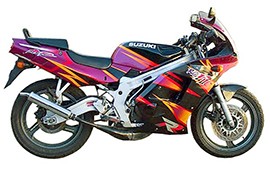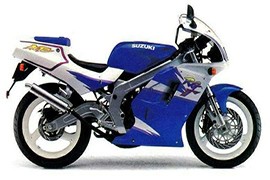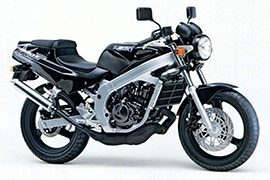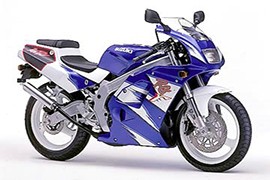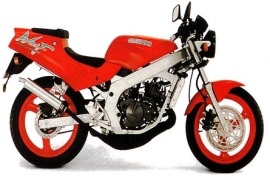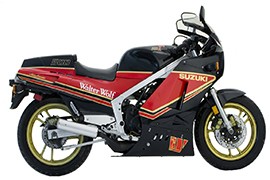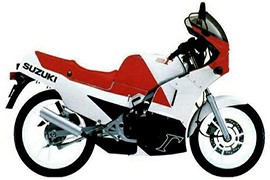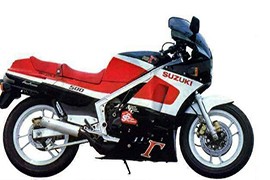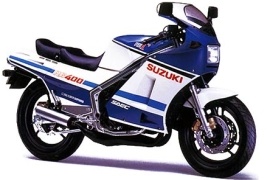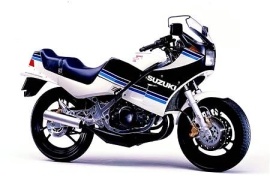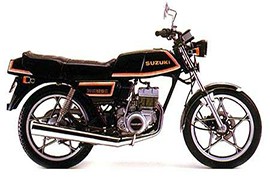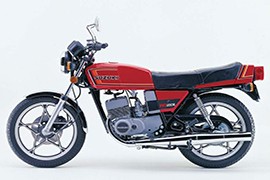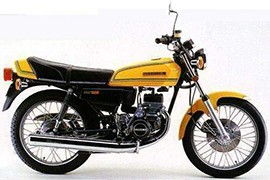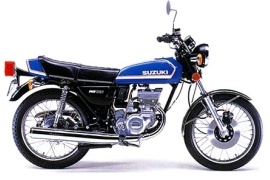SUZUKI RG Models/Series Timeline, Specifications & Photos
First production year: 1978
The Suzuki RG 150 was selected as the second-best new motorcycle of 1998. Also available at the time the RG 150 was produced was the RGV 150 which was a cheaper version with an air-cooled engine and spoke wheels which only had a disc brake on the front. Suzuki FXR150 replaced the RG 150 and RGV 150.
The pressed steel frame is ultra-stiff, ditto the gull-armed swing-arm and 39mm upside-down forks. Front and rear suspension rates, critical on a bike weighing just 125kg, are non-adjustable. Its softly sprung and damped set-up suited me, soaking up bumps which could easily put the RG into orbit were it wrong. The bars are quite wide every control upon them is light and precise which makes the light steering ultra-sensitive. At times, over catseyes or in sidewinds, the RG, always light on its Dunlop K375s, gets a bit frisky but is damn nearly RGV-brilliant.
The Suzuki RG 200 Wolf was basically a naked RG 200F Gamma. The main differencies between the models, except for the fairing, are found
in the rear wheel, the suspension and the brakes. The naked Wolf had narrower rear wheel, simpler swing arm, simpler front fork and larger brake disk at the front but smaller master cylinder diameter
The Suzuki RG 200 Gamma was basically a RG 125F Gamma with a larger engine. Even the gear ratios are exactly the same. Except for the piston displacement and power output (35 ps instead of 22 ps) the only Suzuki RG 200 differencies between the 125cc and the 200cc versions are that the RG 200 gamma has a little larger rear tyre and the chassis and the suspension seems to be injusted for the larger engine. The overall length of the bike is somewhat shorter than the 125 and the 200 is even a bit lower than its little brother.
250cc model with a chic image suited to riders of all ages. The model featured the same engine equipped with a self-starter and the same rigid double cradle frame as the RG 125 Gamma, but the naked 125 Wolf motorcycle didn't feature the new suspension of the RG125 Gamma.
In the engine department, for weight reduction, the model adopted a sleeveless design for the aluminum cylinder head, with the engine paired to an Automatic Exhaust Timing Control II (AETC II), which resulted in an easy-handling unit with a large amount of torque.
The 1991 Suzuki RG 125 Wolf had the thrust generated by a 124cc two-stroke single-cylinder liquid-cooled engine with a power output of 22 hp at 10,000 rpm and 17 Nm (12 lb-ft) of torque available at 9,000 rpm. The power was sent to the rear wheel through a six-speed manual transmission.
The mode packed a 300 mm disc with a four-piston caliper on the front and a 210 mm disc with a two-piston caliper on the rear that delivered stable and powerful braking force.
For suspension, the bike packed an inverted telescopic fork on the front and an adjustable monoshock on the rear.
The race replica wars have certainly come a long way: replicas are now arguably as fast as some of the original racers on which they are based. Like the racing Gamma's, the street-legal RG is a liquid-cooled, twin crank, square four with disc valve induction. Fed by four ultra-thin, 28mm flat slide Mikuni carburetors located on the outside of each cylinder, and with the gas helped by Suzuki's intake power chamber on the way in and their power valve on the way out, the Gamma revs way beyond the redline and makes power in huge peaks of blistering stomp.
RG125 Gamma was introduced in Europe at IFMA '84, the International Bike Show in Cologne, West-Germany, in late 1984. The bike at the show had only a 80cc engine and the 125cc version was to be introduced later. There's nearly no market at all for 125cc motorcycles in West Germany but the 80cc bikes sold very well.
Yamaha's RZ500 V4 two-stroke changed the climate overnight when it was introduced last year. Suddenly grand prix technology didn't seem so preposterous. But Suzuki was fully aware of what Yamaha was up to. The RG500 doesn't look that light or for that matter, feel it. In the current vogue of the Japanese factories, the bike features a full race-styled fairing with rear bodywork that encloses the upper pair of exhaust pipes
and reaches down to the footrests. The RG500 displays a chunky continuity of line that gives only a glimpse of the goingson inside the fairing.
The RG 400 Gamma, like its brothers, copied the Suzuki racer with its four water-cooled cylinder arranged in a square, disc valves and all the latest two-stroke technology. The chassis was as avanced, with an aluminum box frame and Full-Floater rear suspension.
This first mass-produced motorcycle with a lightweight aluminum frame and racing type aerodynamic fairing was manufactured between 1983-1986 and replaced by the V-twin RG 250 one year later. The RG 250 Gamma (presented in March 1983) had a liqued-cooled two-stroke parallel twin engine with 46 hp maximum power output at relative low 8.500 rpm. Returning to the old days, the RG 250 Gamma was a two-stroke, but water-cooled and in a brilliant frame.
The Suzuki RG 125E was launched 1978, simultanously with RG 185, formerly knows as GT 125 and GT 185 with new paint jobs. Neverthelsess, the RG 125 was still sold in some countries with its old name, GT 125. In some countries the model was known as X4. The RG 125 didn't have the Ram-Air cylinder head of the older GT 125.
The Suzuki RG 250E had alloy cast wheels, the RG 250 had classic steel wire rims. There was also some differences in the colors, otherwise, it was the same model.
The RG 250 E is lighter by 20 KG (45 lbs) than the X-7 or GT250-X7 (the Japanese market name) that weighs 146 KG (322 lbs). With a power of only 30 hp (22 kW), the bike has fairly good speed with good power/weight ratio. The Ram Air cooling system is identical to the one used on the GT250.
The Suzuki RG 125 was launched 1978, simultanously with RG 185, formerly knows as GT 125 and GT 185 with new paint jobs. Neverthelsess, the RG 125 was still sold in some countries with its old name, GT 125. In some countries the model was known as X4. The RG 125 didn't have the Ram-Air cylinder head of the older GT 125.
Suzuki RG 185 relates to a popular class of motorcycles with a displacement of from 125cc to 250cc. Here you will get a flexible control, easy steering and light weight of the motorcycle. Therefore, these bikes are suitable for almost every beginner, regardless of its features.
Exceptions are motorcycles with two-stroke engines of classes of "sport" and "cross", as the stories of this class are more powerful and extremely sharp reaction to the throttle, which also does not make them obedient in management.
